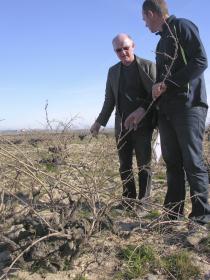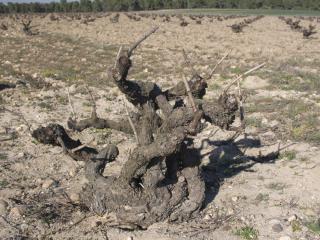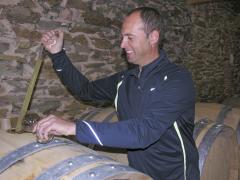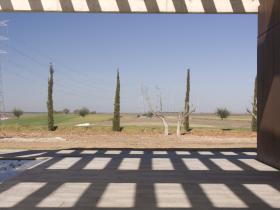Spanish Steppes - Rueda's Whites
POSTED ON 24/04/2009Like airline food and friendly fire, the word great coupled with Spanish white wine has long been one of life’s more amusing oxymorons, albeit not to the Spanish. But the virtues of Galicia’s albariño, with its wonderful pure fruit and fresh acidity, showed how it was the perfect accompaniment to the cornucopia of wine-friendly Atlantic coast seafood. Given a kick up the backside by Galicia, Rioja started to make something of its own hitherto somewhat neutral viura grape. The latest Spanish region to catch the eye is Rueda, whose native verdejo grape, hitherto confined to little more than the tapas bar, has begun to show that in the right hands it’s capable of making distinctive dry white wines of genuine flavour, expression and personality.
 Oz meets his old vine match
Oz meets his old vine match
Rueda is the geographical flip side of the coin to the more famous red wine region of Ribera del Duero . Head north west out of Madrid for a couple of hours towards Spain’s top left-hand corner and you’ll reach Rueda, west of the university city of Valladolid, with the Duero River to its north and Ribera to its east. Home to sheep, pigs, bees and cereals, this is the vast highland plateau of Castilla y Léon, which can range from 700 to 900 metres above sea level. Higher even than some of Argentina’s Andean vineyards, and, with South Tyrol, one of Europe’s highest wine regions, that’s one of its secrets. While you could fry and egg on one of its gravel stones in summer, the temperatures, plummets at nighttime, leaving the grapes fresh and full of crisp natural acidity.
 this vine pre-dates Oz by a century
this vine pre-dates Oz by a century
The other secret of Rueda’s indigenous verdejo, said to have come via the mozárabes from Algeria in the 11th century, is the age of its vines. Ismael Gozalo’s family had been churning out pretty average white wines for five generations before him, but when Vega Sicilia’s ex-winemaker Mariano Garcia spotted the potential of his 150-year-old vines in 2005, Ismael decided to go the quality route and with his partner Javier Zaccagnini, they brought in a French wine consultant, Pierre Millemann, to advise them on using burgundian techniques to create Ossian. The vines are amazing to behold. Like so many giant spindly-legged spiders, thick gnarled trunks sprout from an Atlantic-windswept plain, their sprawling branches curving first up and then groundwards. The 2007 Ossian, £19.06, Justerini & Brooks, is delicious, subtle toastiness from barrel fermentation bringing complexity to the crisp stonefruit flavours and mineral finish.
 Ismael Gozalo
Ismael Gozalo
Victoria Pariente is another local who’s taking the family business to a new level, in fact building a new winery at La Seca near Valladolid to improve the quality of her wines, some of which are also made from old bush vines, others from sauvignon blanc, a relative newcomer to Rueda, tending to more vivid aromas but less body than verdejo. Her 2008 José Pariente Verdejo, £11.30, Theatre of Wine, Greenwich, displays potent greengage plum and exotic grapefruity characters, with a zesty freshness that could almost be good Bordeaux sauvignon. For a couple of more affordable tapas-friendly dry verdejos, try Tesco Finest Rueda 2008, £6.99, with its dash of tropical ripeness and zingy citrusy acidity, or the palatable, citrusy 2007 Carrasviñas Verdejo, £7.50, Great Western Wine, Bath (01225 322810).
 Victoria Pariente
Victoria Pariente
The unoaked style lends it a bracing freshness but the variety works well with oak too, as rioja specialists Marques de Riscal, among the first to modernize Rueda, have shown with their richly full-bodied, lightly smoky 2007 Marques de Riscal Limousin. £8 - £11.99, Cambridge Wine Merchants (www.cambridgewine.com), Edencroft Fine Wines (www.edencroft.co.uk), Winestore.co.uk. Perhaps the greatest exponent of the variety to date is a Frenchman, Didier Belondrade Lerebours, whose intense dry white, Belondrade y Lurton, so called because of his marriage to Bordeaux’ Brigitte Lurton, is a candidate for one of Spain’s best dry whites.
 Belondrade y Lurton
Belondrade y Lurton
His love of Spain, the verdejo grape, and Rueda’s burgundy-like ‘terroir’ and continental climate were the driving forces that led Belondrade to found the company in 1994. He has 19 plots of vines in his 30 hectares, and each are treated differently at the winery to create a dry white of great poise and complexity. Attractievly perfumed, his second wine, the Quinta Apolonia 2007, £11.30-11.99, Raeburn, Edinburgh (0131 343 1159), Amphora Wines, Leicester (01664 565013), is refreshingly zesty and grapefruity. For a glimpse of what Rueda is capable of at its best, the 2006 Belondrade y Lurton, 22.95-£24.50, Tanners Wines, Shrewsbury (01743 234500), The Flying Corkscrew, Leighton Buzzar (01442412312), Uncorked, London (0207 638 5998), is the business, a powerful almost Graves-like dry white of beguiling richness and intensity of peachy flavours, whose delicate oak is seamlessly integrated. Didn’t Didier do well. www.anthonyrosewine.com .
Something For the Weekend 25 April 2009
Under a Fiver
2008 Sauvignon Blanc Vin de Pays du Val de Loire, £4.99, Marks & Spencer
Aromatic, vivacious sauvignon blanc for less than a fiver? This little number, with its elderfloral and nettley scent and typical thirstquenching gooseberry and citrus flavours hits the nail on the head.
Under a Tenner.
2006 Gigondas Notre Dame Des Pallières, £9.99, Majestic Wine
No shrinking violet, this peppery, vibrant southern Rhône blend of grenache, syrah and mourvèdre is so spicy and opulent that, with its heart of powerful black-fruited darkness, you could be forgiven for taking it for Chateauneuf-du-Pape.
Splash Out
2004 Marques de Riscal Rioja Reserva, £12.99, Sainsbury’s
A mature Rioja blend of mainly tempranillo with a dash of the graciano and mazuelo grapes, typical vanilla aromas of oak lead into a beautifully balanced mix of juicily ripe red and black fruits and slinky textures.

